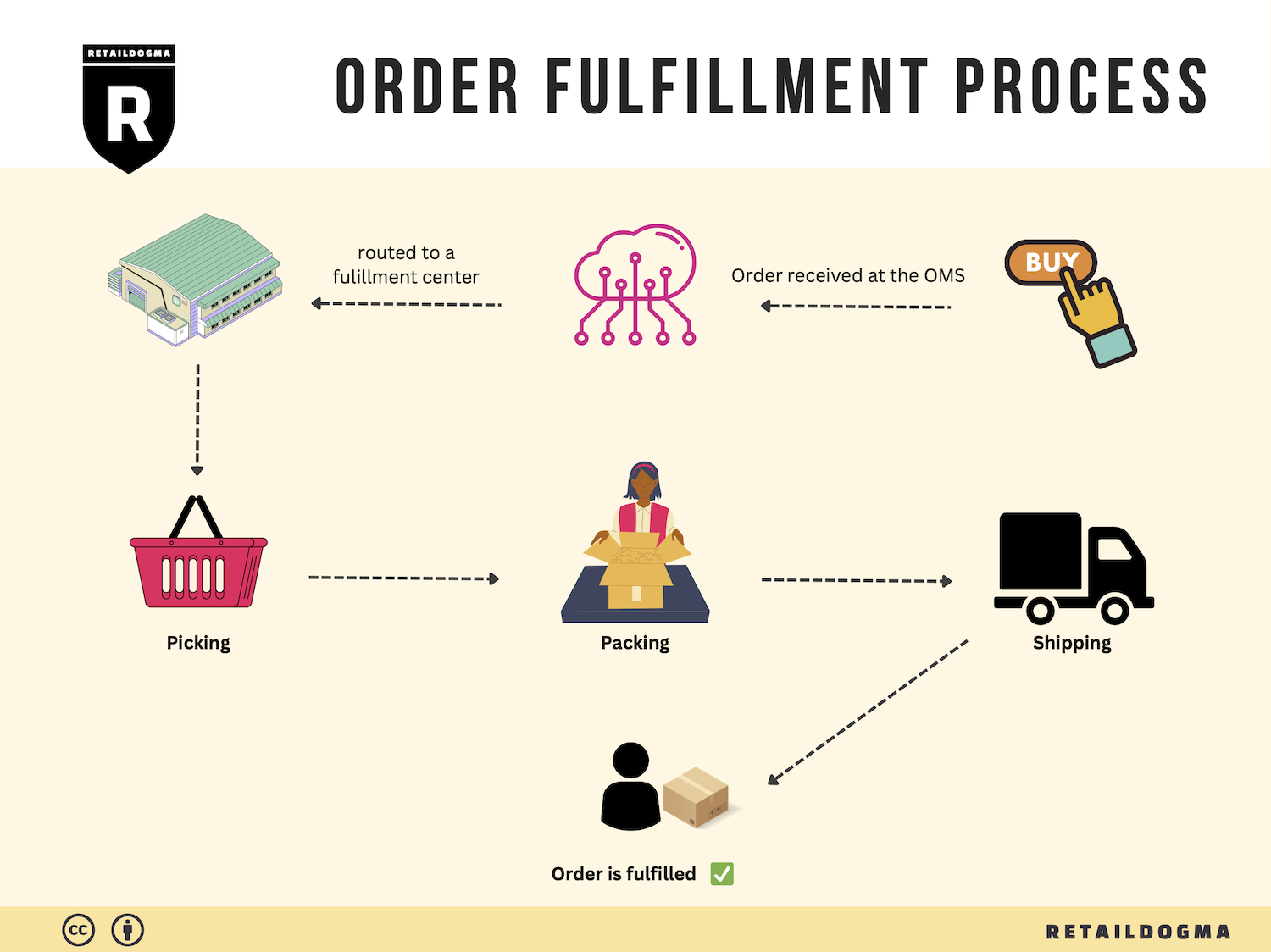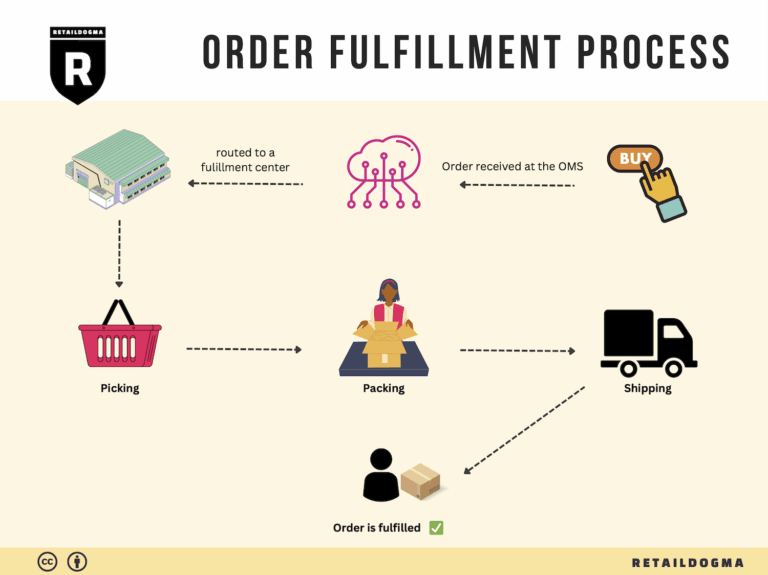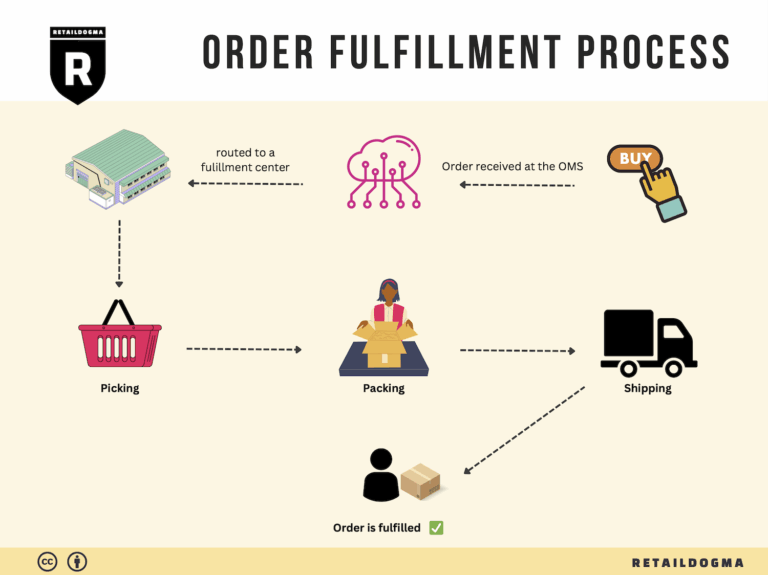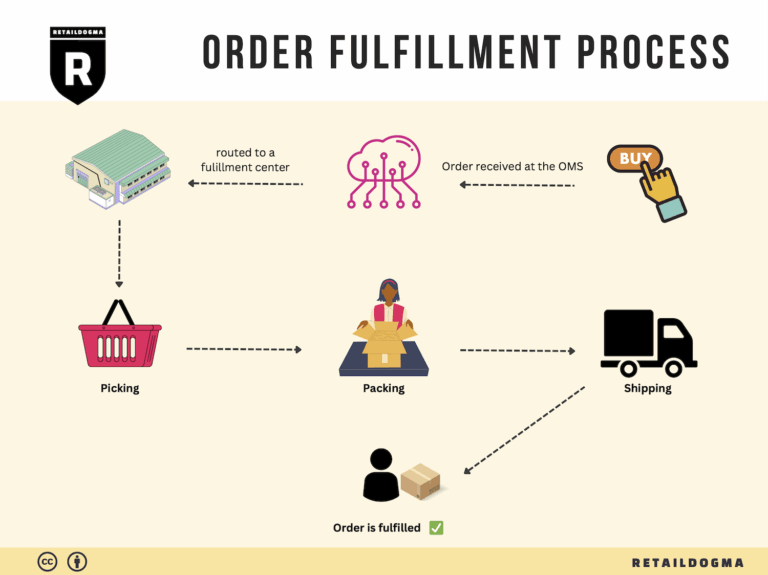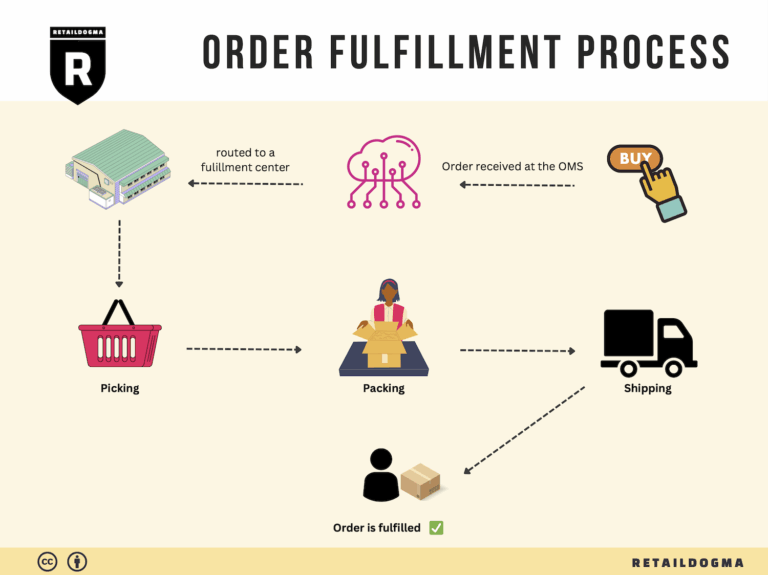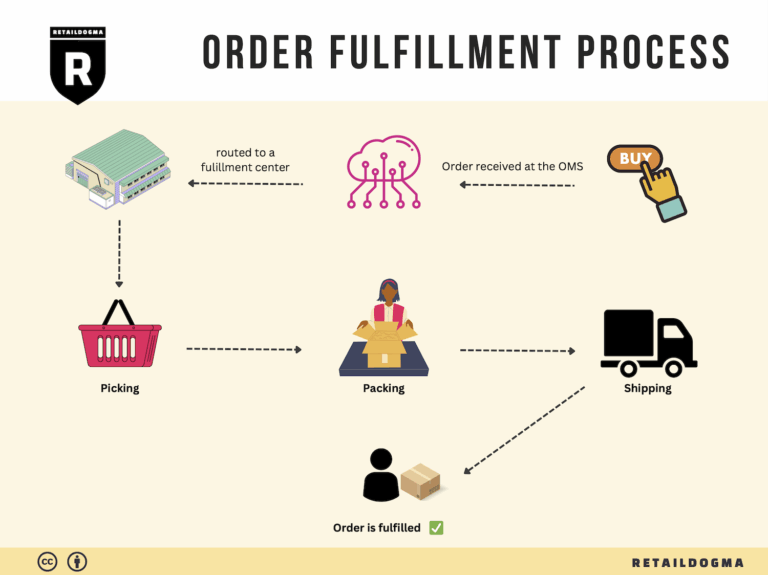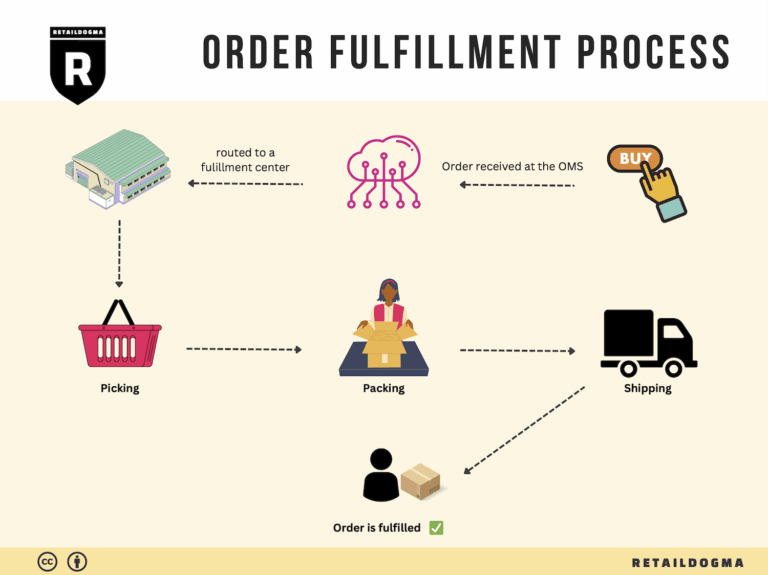Ecommerce Fulfillment Services: The Ultimate Guide (2025)
What is E-commerce Fulfillment? An Introduction for Growing Businesses
Understanding the Challenges of E-commerce Fulfillment
As a growing online business, you may find yourself overwhelmed with the logistics of packing and shipping orders. At first glance, the thrill of launching your brand can quickly diminish when faced with the repetitive tasks of inventory management, order processing, and ensuring timely deliveries. This strain often leads to burnout and can divert your focus away from scaling your business, ultimately impacting customer satisfaction and your bottom line.
What is E-commerce Fulfillment?
E-commerce fulfillment is the comprehensive process of getting a product from your store into the hands of your customers. This goes beyond merely shipping items; it encompasses everything from receiving inventory and processing orders to picking, packing, and shipping, as well as managing returns. In essence, fulfillment is the backbone of your online operations, playing a crucial role in shaping customer experiences and driving repeat business.
What This Guide Will Cover
In this guide, we will delve into various fulfillment models that can support your growth, such as Third-Party Logistics (3PL) and Fulfillment by Amazon (FBA). We’ll explore the core services associated with e-commerce fulfillment, including inventory management, order processing, and shipping options, enabling you to understand what to expect from potential partners.
Choosing the right fulfillment partner is vital to your operational success. We’ll provide insights on how to evaluate potential logistics providers, considering factors like scalability, technology integration, and customer service. Additionally, we’ll discuss pricing structures and common pitfalls to avoid, ensuring you can budget effectively while maximizing efficiency.
Empowering Smart Decisions in Logistics
The ultimate goal of this guide is to empower you, as a business owner or operations manager, to make informed decisions about your logistics strategy. By understanding the intricacies of e-commerce fulfillment, you can streamline your operations, enhance customer satisfaction, and free up valuable time to focus on growth and innovation.
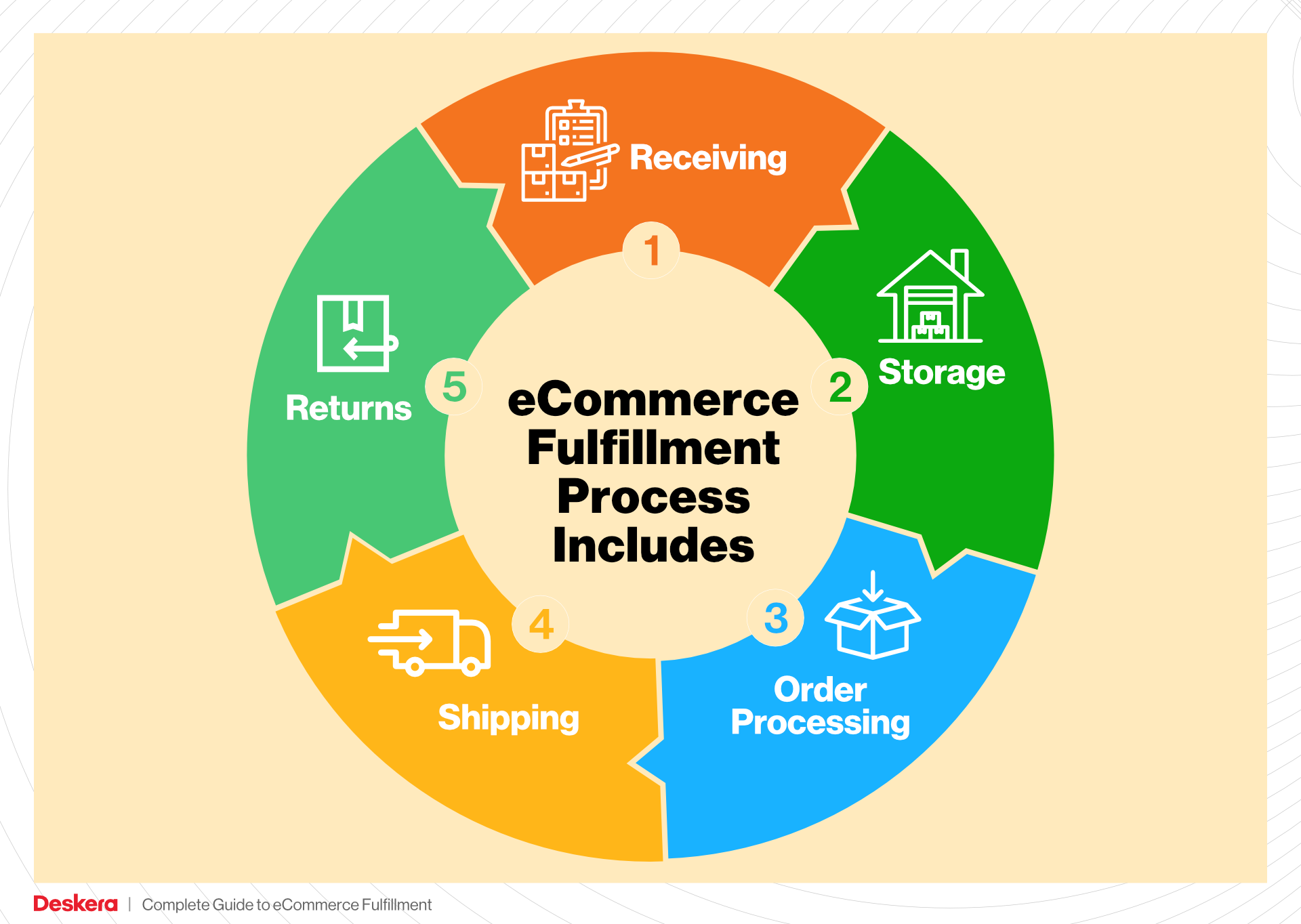
Whether you’re just starting to explore fulfillment options or looking to refine your existing processes, this guide aims to provide you with the knowledge and tools necessary to elevate your e-commerce business to new heights.
What You’ll Learn In This Guide
- What is E-commerce Fulfillment? An Introduction for Growing Businesses
- The Order Fulfillment Process: From ‘Buy’ Button to Customer’s Door
- Comparing Fulfillment Models: In-House vs. 3PL vs. Dropshipping
- A Deep Dive into Amazon FBA: Pros, Cons, and Who It’s For
- Core Services Offered by Fulfillment Centers
- How to Choose a Fulfillment Partner: A 6-Point Checklist
- Understanding Fulfillment Pricing: A Breakdown of Common Fees
- Frequently Asked Questions (FAQs) about Fulfillment
- Conclusion: Is Outsourcing Fulfillment the Right Move for Your Business?
- Important Disclaimer
The Order Fulfillment Process: From ‘Buy’ Button to Customer’s Door
1. Receiving Inventory
The order fulfillment process begins with receiving inventory, a critical step that sets the foundation for your entire logistics operation. When products arrive at your warehouse or fulfillment center, they must be unloaded, inspected for damage, and verified against purchase orders. This verification ensures that the correct quantities have been received and that the products are in good condition.
Why It’s Important: Accurate inventory receiving prevents discrepancies that could lead to order fulfillment errors later on. If you don’t have a clear understanding of what’s in stock, you risk overselling or running out of popular items, both of which can damage customer trust and satisfaction.
Key Term: SKU (Stock Keeping Unit) – Each product should have a unique SKU for easy tracking and management throughout the fulfillment process.
2. Warehouse Storage
Once inventory is received and verified, the next step is organized storage. This involves placing products in designated areas within your warehouse based on a strategic layout that maximizes efficiency. Depending on your product types and order volumes, you might use simple shelving or more complex systems like pallet racking.
Why It’s Important: Effective warehouse storage is crucial for quick access to products during the picking process. A well-organized warehouse minimizes the time spent searching for items, thereby speeding up order fulfillment and reducing labor costs.
Key Term: FIFO (First In, First Out) – This inventory management method ensures that older stock is sold before newer stock, helping to prevent obsolescence and maintain product quality.
3. Order Picking
Order picking is the next pivotal step where your warehouse team retrieves the correct items based on customer orders. This process is guided by picking lists generated from your e-commerce platform, which detail the items needed for each order.
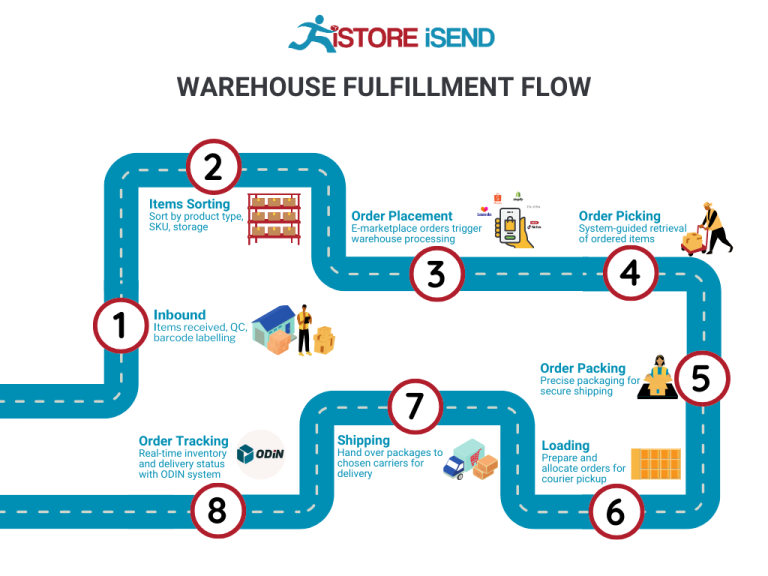
Why It’s Important: Accuracy in picking is vital to customer satisfaction. Mistakes in this step can lead to wrong items being shipped, resulting in returns, refunds, and a tarnished reputation. Efficient picking strategies, such as batch picking or zone picking, can optimize this process further.
Key Term: Pick Lists – These lists guide warehouse staff in selecting the right items, ensuring that the correct products are packed and shipped to customers.
4. Order Packing
After the items are picked, they must be packed securely for shipment. This involves carefully placing products in appropriate packaging that protects them during transit while also creating a positive unboxing experience for the customer. Attention to detail in packing can include using the right box sizes, protective materials, and even branded elements like custom tape or thank-you notes.
Why It’s Important: Proper packing not only prevents damage during shipping but also enhances customer experience, making them more likely to return for future purchases. A well-packed order reflects your brand’s professionalism and commitment to quality.
Key Term: Packing Slip – This document includes details of the order and is included in the package to inform the customer of what they received, further enhancing transparency and trust.
5. Shipping & Delivery
The final step in the order fulfillment process is shipping and delivery. Once orders are packed, they are handed over to shipping carriers who transport them to the customer’s address. It’s essential to choose reliable shipping partners and offer various shipping options to meet customer expectations.
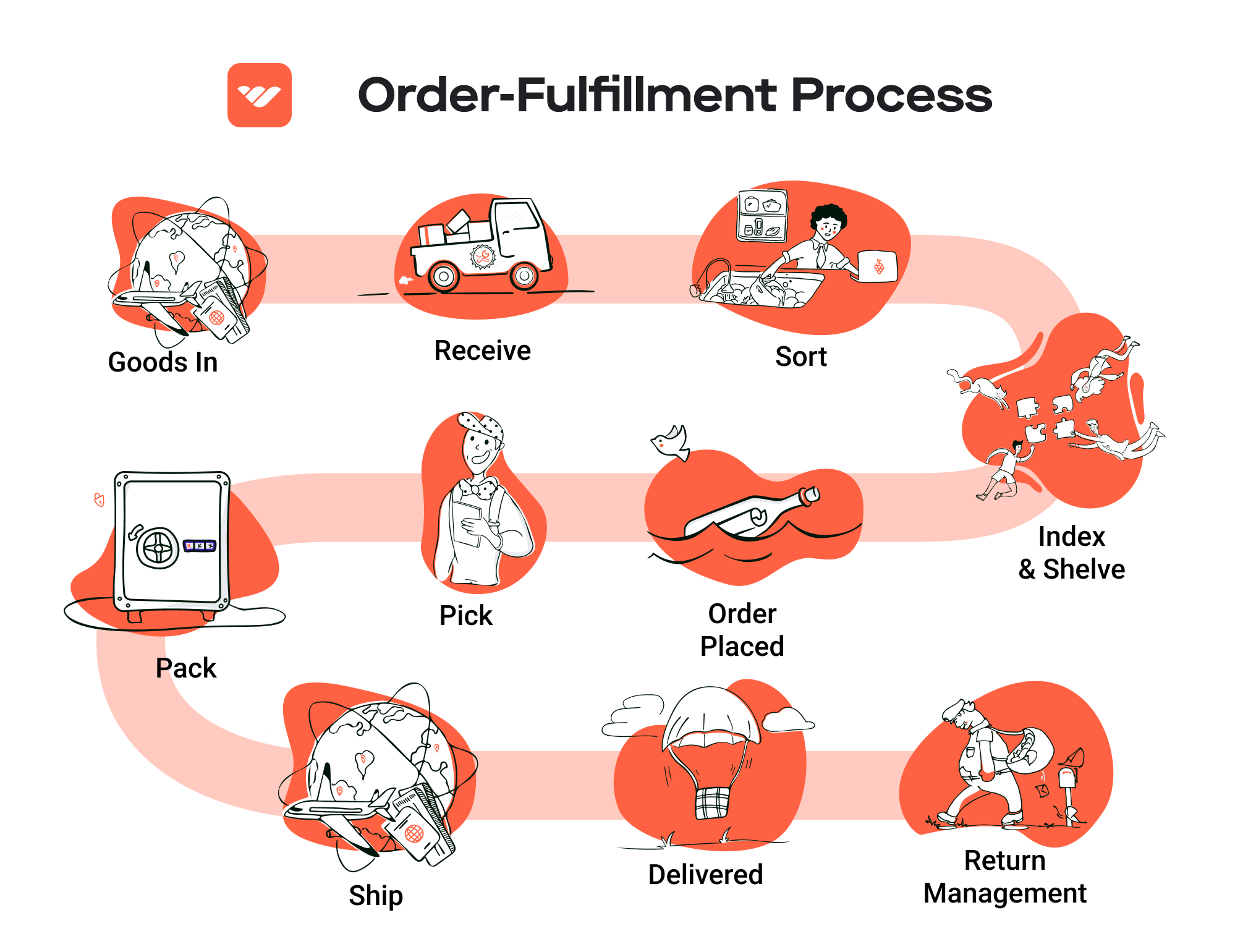
Why It’s Important: Timely and reliable shipping is a major component of customer satisfaction. Delays or lost packages can lead to frustration and loss of trust in your brand. Providing tracking information also helps keep customers informed and reassured about their order status.
Key Term: Last-Mile Delivery – This term refers to the final step of the shipping process, where the package is delivered from a transportation hub to the final destination. Optimizing this step is crucial for ensuring a smooth delivery experience.
By understanding and mastering these five steps of the order fulfillment process, e-commerce businesses can streamline operations, improve customer satisfaction, and ultimately drive growth.
Comparing Fulfillment Models: In-House vs. 3PL vs. Dropshipping
Fulfillment Model Comparison
| Model | Who Handles Inventory | Best For (Business Stage) | Key Advantage | Key Disadvantage |
|---|---|---|---|---|
| In-House Fulfillment | The business itself | Startups to established brands | Complete control over inventory and processes | High operational costs and resource demands |
| Third-Party Logistics (3PL) | A third-party provider | Growing businesses and scaling brands | Scalability and expertise in logistics | Less control over processes and potential integration issues |
| Dropshipping | Supplier or manufacturer | New startups and niche businesses | Low upfront investment and no inventory management | Lower profit margins and reliance on supplier reliability |
In-House Fulfillment
In-house fulfillment involves managing all aspects of the fulfillment process within your own facilities. This model is often chosen by startups and established brands that want direct control over their inventory, order processing, and shipping. By handling fulfillment in-house, businesses can ensure quality control, customize packaging, and create a personalized customer experience. This direct oversight can lead to faster response times and the ability to pivot quickly based on customer feedback or market trends. However, in-house fulfillment comes with significant operational costs, including warehousing, staffing, and technology investments. As order volumes increase, the complexity of operations can also rise, potentially leading to errors that negatively impact customer satisfaction. This model may become unsustainable for businesses that experience rapid growth, where time and resources can become bottlenecks.
Third-Party Logistics (3PL)
Third-party logistics (3PL) providers offer a comprehensive solution for businesses looking to outsource their fulfillment operations. In this model, a specialized logistics company manages inventory storage, order processing, and shipping. This approach is particularly advantageous for growing businesses that need to scale quickly without the hefty investments in warehousing and logistics infrastructure. By partnering with a 3PL, companies can leverage the provider’s expertise in inventory management, shipping logistics, and technology integration, which can lead to improved efficiency and reduced errors. Furthermore, many 3PLs offer advanced systems that sync with e-commerce platforms, providing real-time inventory tracking and automated updates for customers. However, businesses must be aware that outsourcing fulfillment can lead to a loss of direct control over the customer experience and potential challenges with integration between systems. Selecting a reliable 3PL that aligns with the business’s needs is crucial to avoid disruptions in service.
Dropshipping
Dropshipping is a fulfillment model where the retailer does not keep products in stock but instead transfers customer orders directly to a supplier or manufacturer, who then ships the products to the customer. This model is often favored by new startups and niche businesses because it requires little upfront investment in inventory, allowing entrepreneurs to focus on marketing and sales rather than logistics. The flexibility of dropshipping makes it an attractive option for testing new products without financial risk, as businesses can easily add or remove items from their offerings based on demand. However, the dropshipping model also has its drawbacks. Profit margins are generally lower due to the reliance on suppliers, who may dictate pricing and shipping times. Additionally, businesses are dependent on the reliability of their suppliers; any delays or stockouts can lead to customer dissatisfaction and damage the brand’s reputation. Therefore, while dropshipping can be an effective entry point into e-commerce, businesses must carefully select suppliers and manage customer expectations to ensure a positive shopping experience.
Conclusion
Choosing the right fulfillment model is critical for e-commerce businesses as they scale. Each model—In-House Fulfillment, 3PL, and Dropshipping—comes with its own set of advantages and disadvantages. Understanding the unique needs of your business, the stage of growth you are in, and the customer experience you wish to provide will guide you in selecting the most suitable fulfillment strategy. As logistics become a defining factor in the success of e-commerce, investing time in establishing a robust fulfillment process is essential for sustainable growth.
A Deep Dive into Amazon FBA: Pros, Cons, and Who It’s For
Understanding Fulfillment by Amazon (FBA)
Fulfillment by Amazon (FBA) is a service provided by Amazon that allows sellers to store their products in Amazon’s fulfillment centers. Amazon then takes care of the storage, packaging, and shipping of products directly to customers. This service is designed to streamline the logistics process for e-commerce businesses, allowing sellers to focus on other critical aspects of their operations, such as marketing and product development.
How FBA Works
-
Product Listing: Sellers create product listings on Amazon and choose to enroll in FBA. They can either ship their products directly to customers or send them to Amazon’s fulfillment centers.
-
Inventory Management: Once enrolled, sellers ship their inventory to Amazon warehouses. Amazon manages the storage and organization of these products.
-
Order Processing: When a customer places an order, Amazon handles all aspects of order processing, including picking the product from the warehouse, packing it securely, and shipping it to the customer.
-
Customer Service: FBA also includes customer service and returns handling, providing a hassle-free experience for both sellers and customers.
-
Prime Eligibility: Products fulfilled through FBA are eligible for Amazon Prime, giving sellers access to a broader customer base that prefers fast and reliable shipping.
Pros of Fulfillment by Amazon (FBA)
1. Prime Eligibility
One of the most significant advantages of using FBA is the eligibility for Amazon Prime. Prime members benefit from expedited shipping, which can dramatically increase sales for sellers. The Prime badge on product listings can enhance visibility and customer trust, leading to higher conversion rates.
2. Customer Trust and Credibility
Amazon is a trusted platform, and by utilizing FBA, sellers can leverage this trust. Customers often feel more secure purchasing products that are fulfilled by Amazon, as they associate the service with reliability and quality. This can lead to increased sales and repeat business.
3. Multi-Channel Fulfillment
FBA allows sellers to fulfill orders not only from Amazon but also from their own websites or other sales channels. This flexibility means that sellers can manage inventory from a single source while reaching customers across multiple platforms, simplifying logistics and improving efficiency.
4. Time-Saving
By outsourcing fulfillment to Amazon, sellers can free up significant time that would otherwise be spent on packing, shipping, and handling customer service inquiries. This allows entrepreneurs to focus on scaling their business, product development, and marketing efforts.
5. Scalability
FBA offers a scalable solution for businesses of all sizes. As order volume increases, sellers can easily adjust their inventory levels at Amazon’s fulfillment centers without the need to invest in additional warehousing or logistics infrastructure.
Cons of Fulfillment by Amazon (FBA)
1. High Fees
One of the primary drawbacks of FBA is the cost. Amazon charges various fees, including storage fees for keeping inventory in their warehouses and fulfillment fees for each item sold. For some sellers, particularly those with lower margins, these fees can significantly impact profitability.
2. Strict Inventory Rules
Amazon has stringent inventory management rules that sellers must follow. Failing to comply with these rules can result in additional fees or penalties. Sellers are also required to monitor their inventory levels closely to avoid stockouts or excess storage fees.
3. Commingling Risks
When using FBA, sellers’ products may be commingled with those of other sellers in Amazon’s fulfillment centers. This can lead to issues where customers receive the wrong item or counterfeit products. While Amazon has systems in place to mitigate this risk, it can still be a concern for sellers who want to maintain strict control over their inventory.
4. Loss of Control
When using FBA, sellers relinquish some control over the fulfillment process. This can be challenging for businesses that prefer a hands-on approach to inventory management and customer service. Additionally, issues such as shipping errors or delays can occur, impacting customer satisfaction.
5. Dependency on Amazon
Relying on Amazon for fulfillment can create a dependency that may be risky in the long run. Changes in Amazon’s policies, fees, or algorithms can affect sellers’ businesses significantly. It’s essential for sellers to maintain a diversified sales strategy to mitigate this risk.
Who is FBA Best For?
Fulfillment by Amazon is best suited for e-commerce entrepreneurs and businesses that are looking to scale their operations without the logistical burden of managing fulfillment themselves. Here are some specific scenarios where FBA may be particularly advantageous:
-
Startups and Small Businesses: New businesses can leverage FBA to tap into Amazon’s massive customer base without upfront investments in warehousing and logistics.
-
High-Volume Sellers: Businesses with a steady stream of orders can benefit from the efficiency and speed of Amazon’s fulfillment network.
-
Sellers with Seasonal Products: FBA allows sellers to manage fluctuations in inventory levels during peak seasons without the overhead of maintaining a warehouse.
-
Brands Looking to Expand: For brands aiming to reach international markets, FBA offers an established platform that simplifies the complexities of cross-border shipping and fulfillment.
-
Sellers Seeking Convenience: Entrepreneurs who wish to focus on marketing, product development, or other core business areas will find FBA a valuable partner in managing logistics.
In conclusion, while Fulfillment by Amazon offers numerous benefits, it’s essential for sellers to weigh these against the potential drawbacks. Understanding both sides will enable e-commerce entrepreneurs to make informed decisions about whether FBA aligns with their business goals and operational needs.
Core Services Offered by Fulfillment Centers
Inventory Management & Warehousing
Inventory management and warehousing are foundational services offered by fulfillment centers, serving as the backbone of efficient e-commerce operations. This process begins with the receiving of inventory, where goods from suppliers are unloaded, quantities verified, and inspected for damages. A well-organized warehouse is crucial for maintaining accurate inventory levels, which directly impacts order fulfillment speed and accuracy.
The benefits of effective inventory management extend beyond just keeping track of stock levels. It enables e-commerce businesses to optimize their storage space, reduce overhead costs, and improve order accuracy. By leveraging advanced inventory management systems, fulfillment centers can provide real-time visibility into stock levels, allowing businesses to make informed decisions about reordering and stock allocation. This level of insight is invaluable, especially for businesses experiencing rapid growth or seasonal fluctuations in demand.
Additionally, utilizing a fulfillment center for warehousing eliminates the need for businesses to invest in their own physical space and infrastructure. This frees up capital that can be better spent on marketing, product development, or customer acquisition strategies. By outsourcing warehousing, businesses can scale their operations without the burden of managing a physical location, making it easier to adapt to changing market conditions.
Pick and Pack Services
Pick and pack services are at the heart of the fulfillment process, transforming online orders into delivered products. This service encompasses several critical steps: picking the right items from the warehouse based on customer orders, packing them securely for shipping, and preparing them for dispatch. Fulfillment centers often employ various picking strategies, such as batch picking or zone picking, to enhance efficiency and speed.
The primary benefit of pick and pack services is the significant reduction in order processing time. With dedicated staff and optimized systems in place, fulfillment centers can quickly assemble orders, ensuring that they are shipped out promptly. This efficiency not only improves customer satisfaction through faster delivery times but also minimizes the likelihood of errors, such as shipping incorrect items, which can lead to costly returns and dissatisfied customers.
Moreover, the packing process is designed to enhance the unboxing experience for customers. Fulfillment centers can incorporate branded packaging materials, ensuring that the product arrives in pristine condition and leaves a lasting impression. A well-executed pick and pack operation ultimately contributes to a seamless customer experience, encouraging repeat purchases and fostering brand loyalty.
Kitting and Assembly
Kitting and assembly services offered by fulfillment centers cater to businesses that sell products requiring bundling or assembly before shipping. This process involves grouping individual items into a single package or assembling components to create a finished product. This service is particularly beneficial for companies that offer subscription boxes, promotional bundles, or products that require assembly, such as furniture or electronics.
The advantage of kitting and assembly is the ability to streamline the order fulfillment process for complex products. By outsourcing these tasks to a fulfillment center, businesses can ensure that their products are prepared correctly and efficiently, reducing the risk of errors during the assembly phase. This not only saves time but also allows companies to focus on their core competencies, such as product development and marketing.
Additionally, kitting can enhance the perceived value of a product. Offering curated bundles can attract more customers and increase average order value, as consumers are often drawn to the convenience of purchasing multiple related items together. This strategic approach can lead to higher sales and improved customer satisfaction, making kitting and assembly a valuable service for scaling e-commerce businesses.
Returns Management (Reverse Logistics)
Returns management, or reverse logistics, is a crucial service provided by fulfillment centers that deals with the process of handling returned products. In e-commerce, where return rates can be significantly higher than in traditional retail, having an efficient returns management system is essential for maintaining customer satisfaction and minimizing losses.
Fulfillment centers streamline the returns process by providing clear guidelines for customers, managing return authorizations, and quickly processing returned items. This service includes inspecting returned products, restocking them if they are in sellable condition, and handling any necessary repairs or refurbishments. By efficiently managing returns, fulfillment centers help businesses recover value from returned items and reduce the overall impact of returns on profitability.
The benefits of effective returns management are multifaceted. Firstly, it enhances customer trust and satisfaction, as customers are more likely to make a purchase if they know they can easily return items if needed. Secondly, it provides valuable data insights into return reasons, which can inform product development and marketing strategies. Lastly, efficient returns processes can lead to reduced operational costs, as businesses can minimize the time and resources spent on handling returns.
In conclusion, partnering with a fulfillment center for these core services—inventory management and warehousing, pick and pack services, kitting and assembly, and returns management—enables e-commerce businesses to scale effectively, reduce operational burdens, and enhance overall customer satisfaction. By leveraging the expertise and infrastructure of fulfillment centers, entrepreneurs can focus on growing their business while ensuring that their logistics operations run smoothly and efficiently.
How to Choose a Fulfillment Partner: A 6-Point Checklist
Location & Warehouse Network
Why It Matters:
The geographical location of your fulfillment partner’s warehouses directly affects shipping costs, delivery times, and overall customer satisfaction. A partner with strategically placed warehouses can expedite shipping and reduce costs, especially if you are targeting specific regions or planning to expand internationally.
Questions to Ask:
– Where are your warehouses located, and how do those locations align with my primary customer base?
– Do you have a network of warehouses that can support my growth plans, including international shipping?
– How does your shipping strategy optimize delivery times and costs for different regions?
Technology & Integrations
Why It Matters:
In today’s digital landscape, seamless integration between your e-commerce platform and your fulfillment partner is crucial for efficient operations. The right technology can enhance order processing, inventory management, and customer communication, leading to a smoother overall experience.
Questions to Ask:
– What technology platforms do you use for order management, inventory tracking, and shipping?
– Can your systems integrate with my existing e-commerce platforms (e.g., Shopify, WooCommerce, Amazon)?
– Do you provide real-time tracking and reporting capabilities for both my team and my customers?
Specializations (e.g., cold storage, oversized items)
Why It Matters:
Different businesses have unique product requirements. If you sell perishable goods, oversized items, or specialized products, you need a fulfillment partner that can accommodate these needs. A partner with the right specialization can ensure that your products are stored and shipped under the right conditions.
Questions to Ask:
– What types of products do you specialize in handling?
– Do you have specific facilities for temperature-sensitive items or oversized products?
– What processes do you have in place to ensure the quality and safety of specialized products during storage and shipping?
Scalability & Capacity
Why It Matters:
As your business grows, your fulfillment needs will change. A partner that can scale with you will allow you to adjust to increased order volumes without significant disruptions or delays. Understanding their capacity can help you avoid bottlenecks in your supply chain.
Questions to Ask:
– How do you handle seasonal spikes in order volume?
– What is your current capacity, and how can it accommodate my growth over the next few years?
– Do you have contingency plans in place for unexpected increases in demand?
Pricing and Contracts
Why It Matters:
Understanding pricing structures and contract terms is essential for maintaining profitability. Hidden fees can quickly eat into your margins, so it’s vital to have a clear picture of all costs involved. Additionally, flexible contract terms can provide you with the agility to adapt to market changes.
Questions to Ask:
– Can you provide a detailed breakdown of your pricing model, including any hidden fees?
– What are the terms of your contract, and do you offer flexibility for scaling or changing services?
– How do you handle pricing changes, and how will I be notified of any adjustments?
Customer Support & Reviews
Why It Matters:
Responsive and reliable customer support is crucial, especially when issues arise. A partner with a solid reputation for customer service can provide peace of mind and help resolve problems quickly. Additionally, reviews and testimonials can offer insights into the experiences of other businesses.
Questions to Ask:
– What support channels do you provide (e.g., phone, email, chat), and what are your response times?
– Can you share case studies or references from businesses similar to mine?
– How do you handle complaints or issues related to order fulfillment, and what is your process for resolution?
Conclusion
Choosing the right fulfillment partner is a critical decision that can significantly impact your e-commerce business’s growth trajectory. By using this checklist, you can systematically evaluate potential partners to ensure they align with your operational needs and strategic goals. Don’t rush the process; take the time to ask the right questions and gather all necessary information to make an informed choice. The right partner will not only enhance your fulfillment capabilities but also contribute to your overall success in the competitive e-commerce landscape.
Understanding Fulfillment Pricing: A Breakdown of Common Fees
Initial Setup Fees
When partnering with a third-party logistics (3PL) provider, initial setup fees are often the first cost you’ll encounter. These fees can vary significantly based on the complexity of your operations and the services you require.
Calculation: Initial setup fees typically cover the cost of onboarding your business into the fulfillment center’s systems. This may include:
- Software Integration: Connecting your e-commerce platform (like Shopify or WooCommerce) to the 3PL’s system for seamless order processing.
- Inventory Setup: Organizing and cataloging your products in the warehouse, which may involve barcode labeling and SKU assignment.
- Training and Support: Providing necessary training for your team and ensuring you understand how to use the 3PL’s systems effectively.
These fees can range from a few hundred to several thousand dollars, depending on the scale of your operation and the level of customization needed.
Receiving Fees
Receiving fees are charged for the process of unloading and inspecting incoming inventory. This fee is crucial for maintaining accuracy and ensuring your stock levels are correct.
Calculation: Receiving fees are generally calculated based on:
- Volume of Goods: A per-pallet or per-box fee that reflects the amount of inventory being received.
- Complexity of Receiving: Additional charges may apply if your products require special handling, such as fragile items or those needing temperature control.
Understanding this fee is essential, as it can add up quickly, especially if you have frequent shipments or large volumes of products.
Storage Fees (per pallet/bin)
Storage fees are incurred for the space your inventory occupies within the fulfillment center. This is an ongoing cost that can impact your overall fulfillment budget significantly.
Calculation: Storage fees are typically calculated as follows:
- Per Pallet or Bin: Charges are often assessed on a monthly basis per pallet or bin used. The rate can vary based on the type of products stored and the length of time they remain in the warehouse.
- Long-Term Storage: Some fulfillment centers impose additional fees for items stored beyond a certain period (often six months), which encourages quicker turnover of inventory.
To manage these costs effectively, consider implementing inventory management strategies to minimize the time products spend in storage.
Pick & Pack Fees (per item/order)
Pick and pack fees represent the costs associated with retrieving items from storage and preparing them for shipment. This process is critical for ensuring orders are fulfilled accurately and efficiently.
Calculation: Pick and pack fees are calculated based on:
- Per Item or Order: Many 3PLs charge a fee for each item picked, as well as an additional fee for packing the order. Some may offer a flat rate for orders containing multiple items.
- Complexity of the Order: If your order requires special packing materials or instructions (like gift wrapping), additional fees may be charged.
To optimize these fees, consider simplifying your product offerings or utilizing efficient packing methods that reduce the time and resources needed to fulfill each order.
Shipping Fees
Shipping fees are one of the most significant costs associated with e-commerce fulfillment. These fees cover the transportation of packages from the fulfillment center to the customer’s address.
Calculation: Shipping fees can vary widely based on several factors:
- Carrier Rates: Different carriers (UPS, FedEx, USPS, etc.) have varying rates based on distance, package weight, and dimensions.
- Service Level: Expedited shipping options will incur higher fees compared to standard ground shipping.
- Destination: Shipping costs can escalate for international orders due to customs and import fees.
Many fulfillment centers offer discounted shipping rates due to their volume, so it’s essential to discuss these options when evaluating potential partners.
Tips for Getting an Accurate Quote
- Be Transparent About Your Needs: Clearly communicate your order volume, product types, and any special requirements to potential 3PL partners.
- Request Detailed Breakdown: Ask for a comprehensive breakdown of all fees, including hidden costs that may arise during peak seasons or due to special handling.
- Consider Long-Term Costs: Look beyond initial setup fees and consider how storage, pick & pack, and shipping fees will impact your bottom line over time.
- Negotiate Terms: Many fulfillment providers are open to negotiation, especially if you can commit to a long-term partnership or high order volumes.
By understanding these common fulfillment pricing models, you can make informed decisions that align with your business goals, helping you scale your e-commerce operations effectively.
Frequently Asked Questions (FAQs) about Fulfillment
1. What is e-commerce fulfillment?
E-commerce fulfillment is the complete process of receiving, processing, and delivering orders to customers. It encompasses inventory management, order processing, picking and packing products, and shipping them to the customer. Effective fulfillment is crucial for customer satisfaction and can significantly impact a business’s growth and operational efficiency.
2. What is the difference between a warehouse and a fulfillment center?
A warehouse primarily serves as a storage facility for goods, focusing on inventory management and bulk storage. In contrast, a fulfillment center is designed specifically for order processing and shipping. Fulfillment centers handle the entire logistics process, including picking, packing, and shipping products directly to customers, making them essential for e-commerce businesses.
3. When should I consider outsourcing my fulfillment?
Outsourcing fulfillment becomes beneficial when your business reaches a point where handling logistics in-house becomes cumbersome. Key indicators include processing more than 10 orders daily, managing multiple SKUs, facing increased customer service complaints regarding shipping, or planning to expand internationally. By partnering with a third-party logistics provider (3PL), you can free up valuable time to focus on growing your business.
4. What is a 3PL?
A third-party logistics provider (3PL) is a company that offers outsourced logistics services to manage aspects of a business’s supply chain. This includes warehousing, inventory management, order fulfillment, and shipping. Utilizing a 3PL can help streamline operations, reduce costs, and improve delivery times, allowing e-commerce businesses to scale effectively.
5. How much do fulfillment services cost?
Fulfillment service costs vary widely based on factors such as order volume, storage space required, shipping destinations, and additional services like returns processing. Generally, costs can range from $1 to $5 per order, plus storage fees that can be charged monthly or quarterly. It’s important to evaluate different providers to find a service that aligns with your budget and business needs.
6. What are the common mistakes to avoid with fulfillment?
Common fulfillment mistakes include waiting too long to outsource, choosing a fulfillment partner that doesn’t integrate well with your e-commerce platform, neglecting to plan for international shipping complexities, and failing to have a contingency plan for inventory shortages or shipping delays. Avoiding these pitfalls can save time, reduce costs, and enhance customer satisfaction.
7. How can good fulfillment improve customer experience?
Effective fulfillment enhances customer experience by ensuring timely delivery, reducing errors in orders, and providing real-time tracking updates. Satisfied customers are more likely to become repeat buyers, positively impacting your business’s reputation and sales growth.
8. What are the key components of an efficient fulfillment process?
An efficient fulfillment process includes several key components:
– Inventory Management: Receiving, storing, and tracking products accurately.
– Order Processing: Capturing and verifying order details promptly.
– Picking and Packing: Accurately selecting items and preparing them for shipment.
– Shipping: Choosing reliable carriers and ensuring timely delivery.
9. How does fulfillment impact scalability for my e-commerce business?
Fulfillment directly impacts scalability by determining how efficiently you can process and ship orders as your business grows. A streamlined fulfillment operation allows you to handle increased order volumes without compromising on speed or accuracy, facilitating smoother growth and expansion into new markets.
10. What technologies can enhance my fulfillment operations?
Several technologies can enhance fulfillment operations, including:
– Inventory Management Software: To track stock levels and manage reordering.
– Order Management Systems (OMS): To automate order processing and integrate with e-commerce platforms.
– Warehouse Management Systems (WMS): To optimize storage and picking processes.
– Shipping Software: To streamline label printing and compare carrier rates.
Implementing these technologies can improve efficiency, reduce errors, and ultimately enhance customer satisfaction.
Conclusion: Is Outsourcing Fulfillment the Right Move for Your Business?
The Strategic Advantage of Outsourcing Fulfillment
Outsourcing fulfillment can be a game-changing decision for e-commerce businesses aiming for growth and efficiency. By partnering with a dedicated fulfillment service, you can reclaim valuable time that can be better spent on strategic initiatives like marketing and product development. The burden of managing logistics, from inventory storage to order processing and shipping, can quickly become overwhelming. By delegating these tasks to experts, you not only streamline operations but also enhance your overall productivity.
Scalability is another significant benefit of utilizing a fulfillment partner. As your sales volume increases, so do the complexities of order management. A reliable third-party logistics (3PL) provider can seamlessly adjust to your changing needs, whether you’re scaling up for seasonal demands or expanding into new markets. This flexibility ensures that your business can grow without being hampered by logistics constraints.
Moreover, a fulfillment service brings specialized expertise to the table. These partners have established systems, technology, and best practices designed to optimize the fulfillment process. This means fewer errors, faster shipping times, and ultimately, happier customers. When you choose the right fulfillment partner, you gain not just a service provider but a strategic ally in your growth journey.
As you consider whether outsourcing fulfillment is the right move for your business, take the time to audit your current shipping and logistics processes. Are they efficient? Are they scalable? Are they contributing positively to your customer experience? By answering these questions, you’ll be better equipped to determine if a fulfillment partner is the strategic next step for your business growth. Start evaluating today and position your brand for the success it deserves.
Important Disclaimer
⚠️ Important Disclaimer
The information in this guide is for educational purposes. Fulfillment services, pricing, and platform features change frequently. Always conduct your own due diligence and consult with providers directly before making business decisions.
